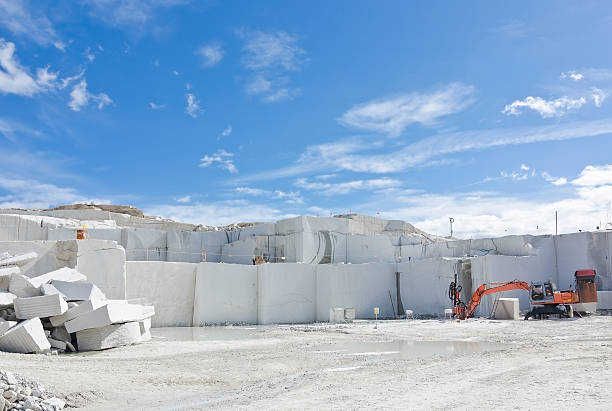A Trip Via Granite Quarries in South Africa: Introduction Nature's Artistry
A Trip Via Granite Quarries in South Africa: Introduction Nature's Artistry
Blog Article
Introducing the Mysteries of Granite Quarrying: Where Strength and Sophistication Meet
The world of granite quarrying is a world where the raw strength of nature merges with human creativity to create structures that stand the examination of time with an air of style. From the midsts of quarries to the meticulous polishing in workshops, the process of changing granite right into architectural wonders is a complicated dancing of custom and innovation. As we peer right into the midsts of this ancient craft, we begin to reveal the surprise ins and outs that form the very essence of our built setting.
The Beginnings of Granite Quarrying
In the annals of architectural background, the origins of granite quarrying are shrouded in a tapestry of old craftsmanship and geological wonders. Going back to ancient Egypt and Mesopotamia, the extraction of granite from quarries marked the start of a journey that would eventually bring about the creation of a few of the world's most legendary frameworks.
Granite quarrying's roots can be mapped to the experienced craftsmens that identified the rock's sturdiness and aesthetic appeal. Through a combination of primitive devices and sheer decision, these early quarry workers unearthed granite blocks that would come to be the foundation of people.
As civilizations progressed, so did the techniques of quarrying granite. The Romans, renowned for their engineering prowess, developed advanced techniques for extracting granite to create monuments, temples, and roads that stood the examination of time.
The heritage of these ancient quarrying techniques proceeds to form contemporary style, with granite remaining a symbol of toughness and sophistication in building jobs around the globe. (granite quarries in south africa)
Tools of the Quarrying Profession
The development of granite quarrying strategies from ancient people to contemporary times highlights the essential duty played by the devices of the quarrying trade in shaping the market's practices. In old times, quarrying tools were simple, commonly consisting of knives, hammers, and wedges made from materials like bronze or iron. These tools needed considerable workforce and time to extract granite obstructs from quarries.

In addition, the intro of pneumatically-driven devices and high-powered machinery has substantially lowered the physical labor called for in quarrying procedures, improving worker safety and security and productivity. As the quarrying sector remains to introduce, the tools of the trade remain at the forefront of driving progression and forming the future of granite extraction.
Removing Blocks of Granite
Using accuracy machinery and progressed methods, the removal of granite blocks from quarries has actually become an innovative procedure in the contemporary quarrying sector. The initial action involves determining the location and size of the granite down payment to determine the most effective removal method. When an appropriate site is picked, the removal process starts with the boring of openings for the positioning of explosives. Controlled blowing up techniques are then used to break apart the granite into workable sections.

Polishing and Ending Up Strategies
To accomplish a remarkable surface area on granite blocks, competent craftsmens employ a collection hop over to these guys of careful sprucing up and finishing methods. After the preliminary removal and forming procedures, the granite obstructs go through a complete sprucing up phase to boost their natural beauty and resilience.
Along with sprucing up, completing techniques are put on more fine-tune the granite's look. These strategies might consist of flaming, developing, or cleaning, each offering special textures and surfaces to match various aesthetic preferences. Flaming, for example, involves subjecting the granite surface to heats to create a harsh, textured surface, suitable for outdoor applications where slip-resistance is necessary. Sharpening, on the other hand, provides a matte surface that is smooth to the touch, excellent for indoor counter tops and floor covering. By very carefully picking and applying these polishing and finishing methods, artisans can transform raw granite blocks into elegant items that showcase both stamina and style.

Environmental Impact and Sustainability
With the growing emphasis on ecological consciousness in the market, granite quarrying methods are progressively inspected for their influence on all-natural resources and long-lasting sustainability. Quarrying for granite can have significant environmental effects. The removal process typically entails the usage of hefty equipment, nitroglycerins, and huge amounts of water, resulting in habitat destruction, soil disintegration, and water pollution. Additionally, the use this link transportation of granite from quarries to processing centers produces carbon emissions, even more contributing to environmental deterioration. granite quarries in south africa.
To reduce these influences and ensure sustainability in granite quarrying, sector stakeholders are adopting various measures. Carrying out sophisticated technologies to decrease power usage and water usage, recovering quarried land for eco-friendly restoration, and promoting responsible sourcing techniques are some strategies being utilized. Furthermore, qualifications such as the Woodland Stewardship Council (FSC) and the Leadership in Energy and Environmental Style (LEED) assistance customers recognize ecologically pleasant granite products.
Final Thought
Finally, granite quarrying is a procedure that needs specialized devices and strategies to extract blocks of granite and brighten them to a high degree of coating. While the environmental impact of quarrying can be considerable, efforts are being made to enhance sustainability basics methods in the market. Overall, granite quarrying is a fragile equilibrium in between harnessing the strength and elegance of this all-natural stone while minimizing its influence on the atmosphere.
Report this page